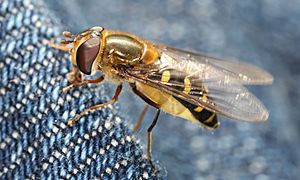Eupeodes lapponicus facts for kids
Quick facts for kids Eupeodes lapponicus |
|
|---|---|
 |
|
| Scientific classification | |
| Kingdom: | |
| Phylum: | |
| Class: | |
| Order: | |
| Family: | |
| Genus: |
Eupeodes
|
| Subgenus: |
Lapposyrphus
|
| Species: |
E. lapponicus
|
| Binomial name | |
| Eupeodes lapponicus (Zetterstedt, 1838)
|
|
| Synonyms | |
|
|
The Eupeodes lapponicus is a common type of hoverfly found across Europe. It's sometimes called the Lapland syrphid fly, which gives a clue about where it likes to live! These amazing insects are often mistaken for bees or wasps because of their yellow and black stripes, but they are actually harmless flies. They play a super important role in nature, helping plants grow and even keeping some garden pests in check.
Contents
What is a Hoverfly?
Hoverflies are a special group of flies that belong to the family called Syrphidae. There are thousands of different kinds of hoverflies all over the world. They get their name because they can hover perfectly still in the air, even when there's a breeze! This amazing trick helps them find flowers to feed on and also helps them escape from predators.
Meet the Lapland Syrphid Fly
The Eupeodes lapponicus is one specific kind of hoverfly. It's known for its distinctive look and its helpful habits. Let's learn more about what makes this little insect so interesting.
What Does It Look Like?
Like many hoverflies, the Lapland syrphid fly has bright yellow and black bands on its body. These colors make it look a lot like a bee or a wasp. This clever trick is called mimicry, and it helps protect the hoverfly from birds and other animals that might want to eat it. Predators usually avoid bees and wasps because they can sting, so they leave the harmless hoverfly alone too!
You can tell a hoverfly apart from a bee or wasp by looking closely. Hoverflies only have two wings, while bees and wasps have four. Also, hoverflies have short, stubby antennae, unlike the longer antennae of bees.
Where Does It Live?
The Eupeodes lapponicus is found throughout many parts of Europe. Its name, "lapponicus," comes from Lapland, a region in northern Europe. This suggests that it's well-adapted to cooler climates, though it can be found in many different habitats, from forests to meadows and even gardens. They are often seen flying around flowers, especially in sunny areas.
What Does It Eat?
What a hoverfly eats depends on its stage of life. Adult Eupeodes lapponicus hoverflies love to drink nectar from flowers. Nectar gives them energy, and as they move from flower to flower, they help to pollinate plants. This means they carry pollen from one flower to another, which helps the plants make seeds and grow new plants.
The larvae (baby hoverflies) of Eupeodes lapponicus have a very different diet. They are often predators of small, soft-bodied insects, especially aphids. Aphids are tiny pests that can harm plants by sucking out their sap. So, these hoverfly larvae are like tiny superheroes for plants, helping to control pest populations naturally!
The Hoverfly Life Cycle
Like many insects, the Eupeodes lapponicus goes through several stages in its life, a process called metamorphosis.
- Egg: The female hoverfly lays tiny, white eggs, often near colonies of aphids, so her babies will have food when they hatch.
- Larva: When the eggs hatch, a small, legless larva emerges. These larvae are usually green or brown and look a bit like slugs. They spend their time crawling around on plants, gobbling up aphids.
- Pupa: After growing big enough, the larva changes into a pupa. This is a resting stage, similar to a butterfly's chrysalis. Inside the pupa, the hoverfly transforms into its adult form.
- Adult: Finally, the adult hoverfly emerges from the pupa. It will then fly, feed on nectar, and mate, starting the cycle all over again.
Why Are Hoverflies Important?
Hoverflies, including the Lapland syrphid fly, are incredibly important for our environment.
- Pollinators: As adults, they are excellent pollinators. They visit many different types of flowers, helping plants reproduce. This is vital for growing fruits, vegetables, and many other plants that animals (including us!) rely on.
- Pest Controllers: The larvae of many hoverfly species, like Eupeodes lapponicus, are natural pest controllers. By eating aphids and other soft-bodied pests, they help farmers and gardeners protect their crops without needing to use harmful chemicals. This makes them a great example of biological control.
So, next time you see a yellow and black insect hovering in your garden, take a closer look! It might just be a harmless and helpful hoverfly doing its important work.

